A starting point for the big test
I started this line of testing almost a year ago with the goal of developing a better understanding of the factors that go into the degradation of signatures on baseballs. This is a subject with lots of anecdotes but little in the way of scientific research. I started with a simple question: what causes such drastic differences in how signatures age as can be seen in these baseballs signed more than 20 years ago?
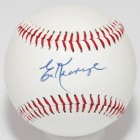 |
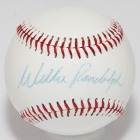 |
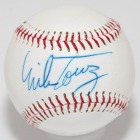 |
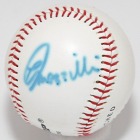 |
| Ed Kranepool | Willie Randolph | Mike Torrez | Lee Mazzilli |
The Kranepool looks like it was signed just a few months ago, but the Randolph has faded away to almost nothing. The Torrez shows quite a bit of bleeding, but the Mazzilli is a complete disaster. All four are on the same kind of baseball, so the only variables are the ink, exposure to light, and the pressure and movement used to make the signature. I can’t do much with that last one, but the others are easy enough to test. The first rounds of testing provided the following results that shaped the test that is just now starting.
1. Leaving a ball open to air appears to result in damage to the ball’s surface when placed in direct sunlight
Test Ball #1
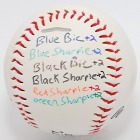 |
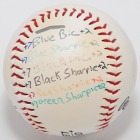 |
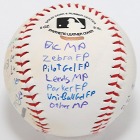 |
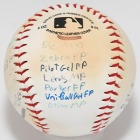 |
| 31 July 2013 | 16 January 2014 | 17 January 2014 | 8 April 2014 |
The exact reason for this is not known and it isn’t clear from the preliminary tests whether the material of the enclosure or just the presence of an enclosure is what prevents it, but this type of damage only appeared in the unprotected ball. Surface damage is not the focus of our testing, so all future tests will include the use of a ball cube (or the box from the ball cube in the case of control balls not exposed to light). Preliminary testing has shown that a ball cube provides sufficient protection to prevent surface damage even in full direct sunlight, allowing for maximum sunlight exposure while limiting the damage to just the ink.
2. Most ink types will bleed on synthetic leather when not exposed to light even when no bleeding is seen in the light-exposed counterparts
Test Ball #3
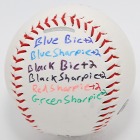 |
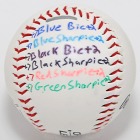 |
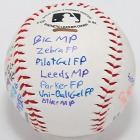 |
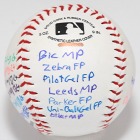 |
| 31 July 2013 | 16 January 2014 | 17 January 2014 | 8 April 2014 |
Test Ball #3 was kept in the dark for the duration of this test and exhibited signaficant bleeding of even the blue ballpoint at the 7+ month mark. The second test hasn’t been going for long enough to reach that level, but the no-name ink is already showing some bleeding. This would seem to make the ideal storage solution a bit more complicated. We could just say “use a blue ballpoint and keep the signature away from all light” and be done with it, but then bleeding would come into play. Based on preliminary testing, it takes several months for bleeding to become apparent. As confirmation of this phenomena, here are three baseballs of the same material signed in the same ink on the same day (July 23, 2013):
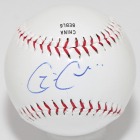 |
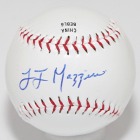 |
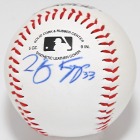 |
| Gavin Cecchini | L.J. Mazzilli | Ricky Knapp |
The difference was that the Cecchini and Mazzilli were on display in an area exposed to indirect natural light and artificial light while the Knapp was in a dark corner a few feet away. After about 4 to 6 months, bleeding was apparent. We’ll need to keep an eye on this (especially for the natural vs. synthetic leather comparison), but a separate test (not currently planned) will be required to identify the exact mechanisms at work.
3. Blue Sharpie, Black Bic, and Red Sharpie are not suitable for use on synthetic leather baseballs
7+ Months Later
 |
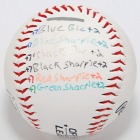 |
 |
| No Protection | Ball Cube | Darkness |
The amount of degradation seen with black Bic and red Sharpie was so severe that there does not seem to be any reason to include them in additional testing at this time. Blue Sharpie also seems to be a bad choice, but there will be a blue Sharpie Pen in this test (the previous tests used a Sharpie CD/DVD marker which may have used a different ink with different durability properties). The addition of natural leather balls will also be a factor here.
4. Ink brand matters
2+ Months Later
 |
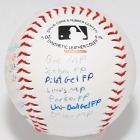 |
 |
| No Protection | Ball Cube | Darkness |
It seems obvious, but the last preliminary test clearly demonstrated a difference in fading pattern between ink from different manufacturers. Most notable is Leeds ink, which faded into a darker blue and remained darker than any of the other ballpoint inks. The Parker also seemed to change very little, starting out lighter than the others and fading somewhat less. This validates the need for a wider test of ink brands.
5. Fine point does not seem to offer an advantage
If anything, the fine point pens appear to be less suitable than medium point because they do not put as much ink on the surface. Fine vs. medium vs. bold may still be a factor in the legibility of signatures, but that is beyond the scope of this test (and isn’t much of a factor with largely illegible signatures these days).
6. Gel ink is not suitable for autographs
The good news is that the gel inks tested resisted fading better than any of the ballpoints. The bad news is that this appears to be due to putting more ink onto the ball, which means longer drying times and pooling of the ink. The increased risk of smudging makes this type of pen unsuitable for our purposes. This may also apply to rollerballs but has not been tested.
7. The “UV Protected” Ultra PRO ball cube does not appear to offer any more protection than other Ultra PRO ball cubes
Lab testing in a controlled environment would be needed to confirm this, but the two models appear to be equivalent except for the hologram on the bottom of the UV protected model. I would show the side-by-side of the balls in each enclosure, but…
8. Dog slobber is the universal solvent
Test Ball #4
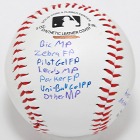 |
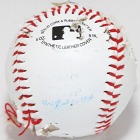 |
| Before Dog | After Dog |
Just as I was wrapping this test up (and shortly after I had compared the two balls in ball cubes to check for any differences), the ball from the UV protected cube showed up in the condition shown on the right. Almost all of the markings are gone, including the gel ink and metallic Sharpie. The lesson: keep your autographs away from dogs. Incidentally, I found this ball while I was constructing enclosures to keep stray indoor light and prying noses out of the test area. It was too late to save Test Ball #4 though. It will be missed.
Comments are closed.